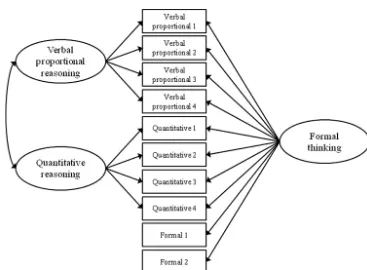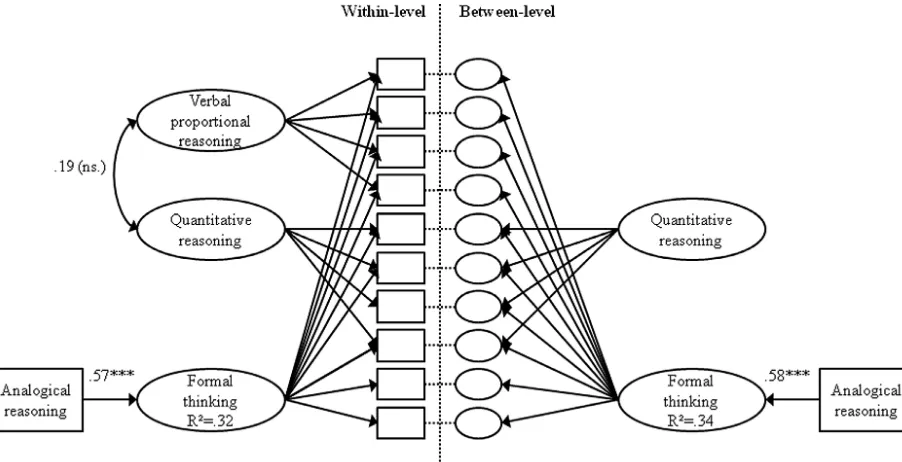ContentslistsavailableatScienceDirect
Thinking
Skills
and
Creativity
jo u r n al hom e p ag e : htt p : / / w w w . e l s e v i e r . c o m / l o c a t e / t s c
General
and
specific
thinking
skills
and
schooling:
Preparing
the
mind
to
new
learning
Mari-Pauliina
Vainikainen
∗,
Jarkko
Hautamäki,
Risto
Hotulainen,
Sirkku
Kupiainen
UniversityofHelsinki,DepartmentofTeacherEducation,CentreforEducationalAssessment,Finland
a
r
t
i
c
l
e
i
n
f
o
Articlehistory:
Received3October2014
Receivedinrevisedform17April2015 Accepted23April2015
Availableonlinexxx
Keywords:
Thinkingskills Cognitivedevelopment Formalthinking
Class-effectonthinkingskills Nestedmultilevelfactorialmodels
a
b
s
t
r
a
c
t
Enhancingthinkingskillsisanimportantgoalofformaleducation.Itisoftenembedded innationalcurricula,which,however,areseldombasedontheoreticalunderstandingof thestructureoftheskillsorhowtheyshouldbetaught.Accordingly,thereisonlylimited informationavailableaboutschools’successinthisimportanttask.Thepresentstudyhas twogoals:firstly,tofindsupportforthetheoreticalassumptionofthenestedstructureof thinkingskillswithacorefactorofformalthinkingandspecialisedstructuresforverbaland quantitativereasoning;andsecondly,totestthedifferentiateddevelopmentoftheseskills inschool.Thiswasdonebystudyingclass-levelvariationofsixthgraders’thinkingskillsin amultilevelfactoranalysiswheninitialbetween-classdifferencesatgradethreehadbeen takenintoaccount.Thedata(N≈1543)weredrawnfromalearningtolearnpanelstudyin oneofthemajorcitiesofFinland.Theresultsshowedthatthecorefactorforformalthinking couldbeidentifiedatboththeindividualandtheclasslevel,andthatattheindividuallevel therewerestatisticallysignificantresidualfactorsforverbalandquantitativereasoning. Initialbetween-classdifferencesexplainedonlyathirdofthevarianceofclass-levelformal thinking.Thiswasinterpretedtoindicatetheeffectofschooling.
©2015PublishedbyElsevierLtd.
1. Generalandspecificthinkingskillsandschooling
Discussionsofcurrentworkingenvironmentsandoftheskillsnecessaryforworkcallfora newapproach towards learning.Inthecontinuouslychangingworkenvironmentspeopleneedtomakecoherentdecisionswithaccessto unlim-itedinformationinalimitedtime,tothinkcreatively,toadjusttheiractionsandattitudesaccordingtopossiblerisksand problems,tolearnquickly,and totrusttheirproblemsolvingskills(Halpern,2008).Hence,educationalpolicymakers world-widehavelatelybecomeinterestedinconcepts,suchaslearningtolearn,thinkingskills,and21stcenturyskills (Recommendation2006/962/ECoftheEuropeanParliamentandoftheCouncil,2006;Rocardetal.,2007;Organisationfor EconomicCo-operationandDevelopment(OECD),2013a).
Thecommoncoreforthenewornewlyintroducedconceptsisthattheyalltapunderlyingcognitivecompetencesand non-curriculardomain-generalskillsthatregardanindividual’soveralllearningpreparedness.Dependingontheframework, theseskillsarereferred toascross-curricular, learningtolearn(LTL), transversal,or21stcenturyskills(DeakinCrick, Stringer,&Ren,2014).Regardlessoftheterm,thesedefinitionsemphasisetheimportanceofdevelopingthinkingskillsas
∗ Correspondingauthorat:CentreforEducationalAssessment,UniversityofHelsinki,P.O.Box9,00014Helsinki,Finland.Tel.:+358503465050.
E-mailaddress:mari-pauliina.vainikainen@helsinki.fi(M.-P.Vainikainen). http://dx.doi.org/10.1016/j.tsc.2015.04.006
abasisforfuturelearningfromcoreprocessesandspecialisedstructuralsystemstocriticalthinking(Demetriou,2014). Enhancingthinkingskillshavebeenconsideredasacentralgoalofeducationalreadyfordecades(Resnick,1987),butit isstillquiterarethateducationalsystemspromotesuchdevelopmentdeliberately(aninterestingexceptionisHungary, wherenewframeworksinreading,mathematicsandscienceareallbasedonideasofgeneralandspecificthinkingasan explicitpart,seeCsapó&Szapo,2014).Eventhoughthinkingskillsareexpectedtoimprovewhenpupilsproceedthrough theirformalschooling,strategiesforevaluatingeducationaloutcomesandeffectivenessofschoolingmainlycentreonthe measurementofsubject-specificknowledgeandskillsoratbesttheirapplication.InFinland,theassessmentofgeneral cognitivecompetencesandtheaffectivefactorswhichsupporttheireffectiveuse,togetherlabelledLTL,weredefinedasone ofthemeasurableoutcomesofeducationalreadyinthe1990s(Hautamäkietal.,2002;NationalBoardofEducation,1999). Sincethen,theyhavebeenusedasoneindicatorformonitoringtheeffectivenessofeducation.
LTLisdefinedasthecognitivecompetenceandwillingnesstoadopttonoveltasksandnewlearning(Hautamäkietal., 2002;Hautamäki,Hautamäki,&Kupiainen,2010).InempiricalassessmentofLTL,theassessmenttasksareseentoactivate acomplexofinterrelatedcompetencesandbeliefs,leadingtoanattempttosolvethetasks.Competencereferstothe applicationofgeneralcognitiveschemasandthealreadyacquiredknowledgeorscholasticachievementtonewsituations. Beliefsrefertoanticipatedemotionswhich,onceactivated,leadtocommitmentorrefusal.Definedthisway,LTLcompetences arerelatedtointelligence,understoodinaPiagetianframeworkastheactiveuseofformaloperationalschemas.Fromthis followsthehypothesisthatthecognitiveLTLtasksmeasuregeneralthinkingskills(seeAdey&Csapó,2014).LTLasan educationalgoalisanexplicitpartoftheEUdefinitionofkeycompetencesandofthe21stcenturyskillsintheglobalcontext. However,neitherofthetwopresentsanempiricallytestedmodeltomeasurethecompetences.TheFinnishLTLFramework andscalesareoneoffewattemptstoofferatooltoassessboththecognitiveandthewillingness-orcommitment-related componentsofLTL(DeakinCricketal.,2014).
Theaimofthepresentstudyisontheonehandtotestthetheoreticalassumptionthatthethinkingskillsmeasuredwith theFinnishLTLconstructhaveanestedstructure(cf.,Härnqvist,Gustafsson,Muthén,&Nelson,1994)withformaloperational thinking(seeShayer,1979)atitscoreandwithspecialisedresidualfactorsforverbalproportionalandquantitativereasoning (seeDemetriou,Spanoudis,&Mouyi,2011).Ontheotherhand,theaimistoevaluatewhetherschoolinghasaneffecton theseskillsintheFinnishcontext,wherethinkingskillsaredefinedasagoalembeddedinallschoolsubjectsinthenational corecurriculum(NationalBoardofEducation,2004)butdetailsregardingtheirteachingaremissing.
1.1. Developmentofthinking
Developmentalpsychologistshavelongstudiedthedevelopmentofthinking.Thetheoryofcognitivedevelopment pro-posedbyDemetriouetal.(2011)andDemetriou(2014)involvesbothcentralandgeneralmechanisms,andspecialised capacitysystemsfordifferentdomainsofknowledgeorrelations.Thespatial,verbal,quantitative,categorical,causal,and socialreasoningsystemshavebeenidentifiedbymethodsfromdifferenttheoreticalorigins,andtheyareconsideredas autonomousdomainsofunderstanding,thinking,andproblemsolving.Acriticalfeatureofthistheoryisthatthe develop-mentofthespecialisedsystemsisbothlimitedbyandistherouteintothedevelopmentofthegeneralintellectualprocessor anditsexecutivecontrol(self-regulation).Thatis,thegeneralfactorisalsoamenabletoeducationalinfluence.Thereis evi-dencefromothertheoreticalbackgroundsthathighperformanceonagenerallevelfacilitatestheacquisitionofnewdomain specificskillsespeciallyontheearlyphasesofthelearningprocess(Francis,Fletcher,Maxwell,&Satz,1989;Gustafsson, 2008).Butwhenlearningisbasedonalreadyacquiredskills,thegainsaremorelikelytodependonearlierdomain-specific knowledge.Accordingly,theimprovementsarelikelytobedomain-specific.Allthismeansthatgoodsubject-specific teach-ingmakestheconnectionbetweenspecificknowledge,e.g.theuseofspecificconcepts,withthegeneraluseofconcepts, rulesandtheirapplication.Thisgraduallyleadstogainsalsointhefunctioningofthegeneralmechanisms(Demetriouetal., 2011;Gustafsson,2008).
Oneofthemoststudiedconstructsinthedevelopmentofgeneralthinkingskillsandthefunctioningofthegeneral mechanisms(cf.,Demetriouetal.,2011)isthecontrolofvariablesstrategy(CV),whichisalsooftenreferredtoasthe vary-one-thing-at-a-time(VOTAT) strategy.ItwasfirstintroducedbyInhelderandPiaget(1958)aspartoftheformal operationalthinkingconstruct(seeShayer,1979).RegardlessofcriticismsconcerningexplicitnessofInhelderandPiaget’s workitstillprovidesoverarchingillustrationhowadolescents’cognitivecompetencesdevelopduringtheseconddecadeof theirlife(Kuhn,2008).Theemergenceofformaloperationsataroundage12–15involvesreasoningbasedonhypotheses, independentofconcreteobjects,whichmeans“therealissubordinatedtotherealmofthepossible”(Piaget,2006).Age variationisseentobeingrainedinthedifferingintellectualstimuliinchildren’senvironmentsandtodependonpersonal interestsandexperiences.However,formalthinkingisnotnecessarilyappliedallthetimeoracrossalldomains(Piaget,1972, 2006).Evenifindividualdifferencesinformaloperationalthinkingarerelatedtointelligence,verbalabilityandexecutive functions,theseareconsideredtobepartlyculturallybound(Emick&Welsh,2005).Ithasbeenshownthatthatthecontrol ofvariablesstrategyiscentraltoscienceandanessentialskillattainableandtrainablebythetimechildrenarecognitively advancingfromaconcretetowardaformaloperationallevel(Neimark,1975;Shayer,2008).
Fernandes,2007;Rohde&Thomson,2007;Sternberg,1999).Generalcognitionisexpressedorinvestedinvariousways indifferentlearningsituationsandschoolachievements(Gustafsson&Carlstedt,2006).Butthedevelopmentallyoriented interpretationofgeneralcognitionasanexpressionofgrowthoflogicalthinkingopensupanoptionforintervention(Adey, Csapó,Demetriou,Hautamäki,&Shayer,2007;Shayer,2008).Thisintegratedunderstanding,educatingthedevelopingmind, iswellrepresentedintheworkofDemetriou(2014)andDemetriouetal.(2011).
AccordingtoDemetriou’stheory,weexpectthethinkingskillsmeasuredwithintheFinnishLTLcontexttobestructured inawaythatinadditiontothecoreofformalthinking,residualfactorsofallthespecialisedreasoningsystemsaretobe found.Inpractice,onlytheverbalandquantitativefactorscanbeidentifiedhereasthesixthgradeversionoftheFinnishLTL scaleusedinthepresentstudydoesnothavesufficientnumberofitemsontheareasofspatial,causalorsocialreasoning. Eventhoughninthgradedatawithalargerscopeofcognitivetaskswouldhavebeenavailable,12-year-oldswereselected asthetargetgroupofthepresentstudyduetothesensitivenessofthisagegroupinregardtoboththedevelopmentof formalthinking(Piaget,2006),andtotheenhancementofthinkingskillsingeneral(Csapó,1997).
1.2. Enhancingthedevelopmentofthinkingskills
Manyresearchersseethatinductionprocesses,suchasperformingmentalcomparisonsformabasisfor knowledge-building.This,inturn,hasbeenshowntohaveatransfereffectonlearninginschoolsubjects(Adey&Shayer,1994;Adhami &Yates2008;Bloom,Engelhart,Furst,Hill,&Krathwohl,1956; Klauer&Phye,2008;Tomic&Klauer,1996).Thus, by promotingthedevelopmentofthinkingskills,e.g.howtoputthingsinorder,classifyorperformmentalrotations,we simultaneouslyenhancefundamentallearningskills,whichhavetransfereffectsacrosstheschoolcurriculum.Thisalso facilitatestheattainmentofhigherorderthinkingskills(Anderson&Krathwohl,2001;Shayer,2008).
Itcouldbearguedthattherearetwomainwaystopromotethinkingskillsinschool.Thefirstapproachcanbecalled explicitwithspecificeducationalprogrammes,whichareexpectedtopromotethinkingskillsiftheprogrammeguidelines areappropriatelyfollowed.Theseprogrammescanbefurtherdividedintotwocategoriesaccordingtohowthetraining ofthinkingskillsisarranged(McGuinness&Nisbett,1991).Thefirstcategory,thecontent-basedmethod,consistsof pro-grammeswhichensurethatthinkingskillsaretaughtwithinconventionalcurriculumareas(e.g.mathematicsorscience). Awell-studiedprogrammerepresentingthismethodistheCognitiveAcceleration(CA)Programme(Adey&Shayer,1994) basedonPiagetiancognitivestages.Programmesbelongingtothesecondcategorysharetheideathatthinkingskillscan betaughtassuch(e.g.Feuerstein,Rand,Hoffman,&Miller,1980;Klauer,1989;Klauer,1991).Thepromotionofgeneric skillshasbeencriticisedfordevelopingthinkingskillsa-contextuallyandinhibitingthetransferofthedevelopedskillsto newcontexts.Yet,programmesbasedonKlauer’stheoryhaverecentlyshownstrongevidencefortransfereffectonboth fluidintelligenceandvariousacademicsubjects(Klauer&Phye,2008;Molnár,2011;Molnár,Greiff,&Csapó,2013). Regard-lessofstrongevidencebynowthatspecificprogramscanpromote21stcenturyskills,theirlarge-scaleusehasnotbeen widelyspreadtotheeducationalfieldduetobothshort-sightededucationalpolicy-decisionmakingandlimitedresources ofstakeholders(Pellegrino&Hilton,2012).
Thesecondapproachcanbedescribedasanimplicitone.Inthisapproach,curriculadonotperseemphasisesystematic cultivationofthinkingskillsbutsuchdevelopmentisexpectedtoresultasaside-effect(Kuhn,2005;Molnár,2011).Especially intheNordiccountries,approaches,practices,andinitiativestowardsenhancingthinkingskillsareverylimited.Forexample, intheFinnishnationalcorecurriculum,thinkingskillsareregardedtobelongintoeachconventionalcurriculumarea.Thus, itisexpectedthattheimplementedcurriculumwithannuallymoredemandingcontentcomplexity(spiralcurriculum; cf.Bruner,1960)raisesimplicitlythelevelofthinkingskills,aswell.However,researchhasshownthatthepromotion ofthinkingskillsneedstobeeitherintegratedpurposefullyinthecurriculumortheyhavetobeexplicitlytaughttogain effectiveresults(Adey&Shayer,1994;Kuhn,2005;Nisbett,1993).
AsinFinlandexplicitmethodsforteachinggeneralthinkingskillsarenotpointedoutinthecorecurriculumandthesame classteachertypicallyteachestheirclassfromthirdtosixthgrade,theFinnishschoolsystemallowsustostudyteacher-and class-relatedvariationinthedevelopmentofgeneralthinkingskills.Theexpectedclass-levelvariationinthedevelopment ofthinkingskillscouldprovideevidenceforthatevenimplicitteachingofthinkingskillscanbebeneficial.Itcanalsogive estimatesabouthowmuchoralternativelyhowlittleteacherscaninfluencethedevelopinggeneralthinkingskills.
1.3. Educationalassessmentandthinkingskills
foundbetween-classdifferencescallforfurtherresearchtogainamorecomprehensivepictureregardingthedevelopment of21stcenturyskillsinrelationtosubject-specificlearningandtore-evaluatetheequityoftheFinnisheducationsystem (cf.,Sahlberg,2007).Inthepresentstudy,afirststeptowardsthisdirectionistakenbyanalysingclass-levelvariationinthe thinkingskillsmeasuredbytheFinnishLTLscale.Thelongitudinaldataofthepresentstudyallowscontrollingforinitial differencesbetweenclasses,revealingsomeofthepossibleeffectsschoolinghasproducedascomparedtocross-sectional studies,whichmightjustindicatethenon-randomallocationofpupilsinclasses(cf.,Vainikainen,2014).
1.4. Researchquestionsandhypotheses
Asdescribedabove,thestructureofthinkingskills,theirdevelopmentineducationalsettings,andeducationalequity haveallbeenextensivelystudiedindependentfromeachother.However,thereisverylittleresearch,whichcombinesthese perspectivesandevaluatestowhatextentthinkingskillsreallydevelopasaresultofformalschoolingiftheyarenottaught explicitly.Therefore,theresearchquestionsandthehypothesesofthepresentstudyare
Q1:DothethinkingskillsmeasuredbytheFinnishLTLscaleshaveanestedhigher-orderstructureasthetheoriesabove suggest?
H1:Thereisanestedhigher-orderstructure:thehigher-ordergeneralthinkingskillsfactorisdeterminedbyformal thinkingbutthereareseparablefactorsforverbalandquantitativereasoningskills(Demetriouetal.,2011;Gustafsson, 2008;Piaget,2006;Shayer,1979).
Q2:Istherebetween-classvariationinformalthinkingandtheresidualfactorsofverbalandquantitativereasoning? H2:Thereisbetween-classvariationinallthesefactors,anditexplainsbetween10%and20%ofthevariance(Hautamäki etal.,2013;YangHansenetal.,2014).
Q3:Isthebetween-classvariationexplainedbyinitialdifferencesbetweenclasses,whichhasinearlierstudiesbeen showntoexplainabout5%ofthevariancealreadyatthestartingpoint(Vainikainen,2014),ordoesittellaboutdifferent trajectoriesofdevelopmentindifferentclasses?Thatis,havethedifferencesattheendofsixthgradebeenpartiallycaused byschoolingasthinkingskillscanbeemphasiseddifferentlyinteachingwhenexplicitmethodsarenotspecifiedinthe Finnishcurriculum?
H3:Theclass-levelvariationinthinkingskillsdoesnotonlyreflectinitialdifferencesbetweenclasses:ithasbeenshown earlierthattowardstheendofprimaryschool,between-classdifferencesexplain10–20%ofthevarianceofperformanceon differentdomains,whichismuchmorethaninitialdifferencesbetweenclasses(Vainikainen,2014YangHansenetal.,2014). Toourknowledge,therearenopriormultilevellongitudinalstudiesexplainingthepossibleschoolingeffectsonthinking skills.
2. Methods
ThedataweredrawnfromtheVantaapanelstudy,inwhichfourfullagecohorts(thefirst,third,sixthandninthgraders) ofthemunicipalitywerefollowedfrom2010to2013.Thepresentstudyutilisesthesixthgradedatafrom2013which, regardingthemeasuresusedherewerefirstreportedbyKrkovic,Greiff,Kupiainen,Vainikainen,andHautamäki(2014) andVainikainen(2014).Noneofthesestudieswasaboutthenestedstructureofthinkingskills.Morerecently,weused thenestedmodelinanotherarticleacceptedforpublicationinaFinnishspecialeducationjournal(Vainikainen,Hienonen, HautamäkiandHotulainen,inpress).Inthearticle,weappliedonlyindividual-levelmodellingandshowedthatclasssize didnotexplainthedevelopmentofformalthinkingofpupilswithspecialeducationneeds.Regardingthenestedmodel,we referredtothecurrentstudyastheoriginalpublicationanddidnotrepeatanyoftheresultspresentedhere.
2.1. Participants
Thestudiedcohortoriginallyconsistedof2113sixthgradersin118classesin37schools.Duetothepre-definedexclusion criteria,8smallspecialeducationclassesdidnotparticipate,andabout5%ofpupilswereabsentduetosicknessorother reasons.20%ofthepupilswererandomlyassignedtoapaper-basedassessmentgroupwhereas80%completedthe computer-basedversion(CBA)oftheLTLtest.OnlythedataoftheCBAgroup(N=1543,49.2%girls)wereusedinthepresentstudy, andthefinalnumberofclasseswithsufficientdataformultilevelmodellingwas102.TheageofthepupilswasM=12.67, SD=.43.Longitudinaldatacomprisingalsopupils’thirdgraderesultsinanalogicalreasoning,whichwasutilisedfortesting thelasthypothesis,wereavailablefor1303pupils.ParentswereinformedthroughtheCityEducationDepartment,and77% oftheparentsalsofilledoutabackgroundquestionnaire,whichisnotreportedhere.
2.2. Measures
Table1
Reliabilitiesofthecognitivetasksandtheattitudescales.
Scale Number of items ˛
Verbalproportionalreasoning 10 .55
Quantitativereasoning 15 .75
Formalthinking 4 .62
Analogicalreasoningthirdgrade 8 .78
sometimesfoundgoldandsilvertogether,sometimeshehasfoundsilverbyitself,everyothertimehehasfoundneither silvernorgold.Whichofthefollowingruleshasbeentruefortheprospector?Goldandsilverarefoundtogether,never apart.;ifhefoundsilverthenhefoundgoldwithit.;ifhefoundgoldthenhefoundsilverwithit.;ifhefoundgoldthenhe didnotfindsilver;seeBond,2010formoredetails).Inthelatter,thepupilsweregivenonepremiseandtheconclusion(e.g. Conclusion:LakeSaimaaistoocoldforswimming.Firstfact:thetemperatureofLakeSaimaais5centigrades),andtheyhad tochoosefromamongstfivealternativesthesecondpremisewhichwouldmaketheconclusionvalid(e.g.Mostlakesaretoo coldforswimming.;itiswintertime.;fivedegreewateristoocoldforswimming.;LakeSaimaaisalwayscold.;swimming incoldwaterisnofun.).Theitemswerescoreddichotomouslyascorrectorincorrect.
QuantitativereasoningwasassessedbysevenitemsadaptedfromtheHiddenArithmeticalOperatorstaskbyDemetriou, Platsidou,Efklides,Metallidou,andShayer(1991)andeightitemsbasedontheInventedMathematicalConceptstaskof Sternberg,Castejon,Prieto,Hautamäki,&Grigorenko(2001).Inthefirstsevenitemstherewereonetofourhiddenoperators (e.g.Whichoperatordotheaandbstandforin(5a3)b4=6?).Inthelatteritems,twoinventedarithmeticaloperatorswere conditionallydefined(e.g.ifa>b,lagstandsforsubtraction,butifa≤b,itstandsformultiplication).Afterthedefinition,the pupilshadtoselectthecorrectanswerfromamongstfourmultiplechoicealternativestoeightitems(e.g.Howmuchis7 lag5?).Theitemswerecodeddichotomouslyforthewholeequation.
FormalthinkingwasmeasuredbytheControlofVariablestask,whichisamodifiedversion(Hautamäki,1984seealso Hotulainen,Thuneberg,Hautamäki,&Vainikainen,2014,foradetaileddescriptionofthetask)ofShayer’sScienceReasoning Task‘Pendulum’(1979).ItisbasedononeoftheformalschemataidentifiedbyInhelderandPiaget(1958).Thepupilswere presentedwithfouritemsintheformofcomparisonssetintheworldofFormula1raceswithfourvariables:driver,car, tires,andtrack,withtwoalternativesforeach.Thepupilshadtojudgewhetherthesingleeffectofthedriver,car,tires,and trackcouldbeconcludedfromthecomparison(e.g.Round1:driverRäikkönen,carFerrari,tiresMichelin,trackHockenheim; Round2:driverHamilton,carFerrari,tiresMichelin,trackMonaco;canyouconcludetheeffectsofdriver/car/tires/track ontheresult?)Thereweretwocomparisonswith3or4Yes/No-choicesforthevariablesandtwocomparison-setstobe complemented.Thefouritemswerecodeddichotomouslyforacorrectanswertoallofthevariablesintheitem.
Fortestingthelasthypothesis,pupils’analogicalreasoningscoresfromthreeyearsearlierweremergedintheotherwise cross-sectionaldata.ThetaskwasadaptedfromthegeometricanalogiestestofHosenfeld,vandenBoom,andResing(1997). Thepupilswerepresentedapairofgeometricfigures,thatis,asmallsquareontheleftandabigsquareontheright.The taskwastoapplythesamerulewhenchoosingapairfromfiveoptionsforanotherfigure,thatis,asmallcircle,between5 answeroptions.Thetransformationsincludedaddinganelement,changingsizesandpositions,halvinganddoubling.The maximumnumberofsimultaneoustransformationswasfive.Theeightitemswerecodeddichotomously,andthenumber ofcorrectitemswasconvertedtopercentage.
ThereliabilitiesofthemeasuresarepresentedinTable1.Eventhoughsomeofthereliabilitiesweresomewhatlowdue tothesmallnumberofitems,thereliabilitieswereconcludedacceptableforpopulation-levelstudies.
2.3. Statisticalanalyses
DescriptivestatisticswerecalculatedwithSPSS22.Single-andmulti-levelnestedfactorialmodelsweretestedinMplus 7.2(Muthén&Muthén,2012)usingtheMLRestimatorwithoutimputationofmissingvalues.Toreducethenumberof parameterstobeestimated,theitemsofthesubtestswereparcelledintofourverbalreasoning,fourquantitativereasoning, andtwoformalthinkingparcels,whichweretreatedascontinuousvariables.AccordingtotherecommendationofMarsh, Lüdtke,Nagenkast,Morin,andVonDavier(2013),weusedahomogeneousparcellingstrategy,inwhichitemsfromdifferent theoreticaloriginswerenotmixedinthesameparcelsandtheitemsinoneparcelwereassimilaraspossible.Before parcelling,wecalculatedIRTitemdiscriminationestimatesforthethreescales,ensuringthesufficientunidimensionality ofthescales(seeMarshetal.,2013).ThemodelswereconsideredashavingagoodfitwithCFI&TLI>.95andRMSEA<.05, andanacceptablefitwithCFI&TLI>.90andRMSEA<.08.Alsoreportedare2values,butduetothelargesamplesizeand thenumberofparameterstobeestimatedsignificantp-valuesweretobeexpected.Accordingly,modelswithsignificant p-valueswerenotdiscardedifalltheotherindiceswereacceptable.
3. Results
3.1. Descriptivestatistics
Table2
Descriptivestatisticsofthevariablesusedinmodelling.
Variable
Parcel N Min Max M SD ICC
Verbal proportional 1 1522 .00 1.00 .53 .30 .07
Verbalproportional2 1512 .00 1.00 .54 .39 .07
Verbalproportional3 1506 .00 1.00 .51 .30 .05
Verbalproportional4 1504 .00 1.00 .23 .32 .02
Quantitative1 1501 .00 1.00 .52 .28 .10
Quantitative2 1401 .00 1.00 .10 .22 .03
Quantitative3 1475 .00 1.00 .57 .29 .08
Quantitative4 1471 .00 1.00 .35 .28 .07
Formal1 1495 .00 1.00 .59 .45 .07
Formal2 1480 .00 1.00 .37 .44 .07
Analogical reasoning 1303 0.00 100.00 40.19 29.88
N = Number of responses, Min = minimum value, Max = maximum value, M= Mean, SD = Standard deviation, ICC = Intraclass correlation.
Fig.1.Theexpectednestedstructureofthinkingskills.Theerrortermsofthefactorindicatorsarenotpresentedinthefigure.
3.2. Hypothesis1
Inthefirsthypothesisweexpectedthatthemeasuredthinkingskillswouldhaveanestedfactorialstructure.Thatis,the higher-ordergeneralthinkingskillsfactorwouldbedeterminedbyPiagetianformalthinkingbuttherewouldnevertheless beseparablefactorsforverbalproportionalandquantitativereasoningskills.Totestthishypothesis,themodelpresented inFig.1wasfirsttestedonindividual-leveldatawithoutmodellingbetween-levelvariance.
Thenested modelofFig.1fittedthedatawell(CFI=.978,TLI=.962,RMSEA=.034,2=73.411,df=26,p<.001)and showedabetterfitthananalternativemodelwiththreenon-nestedcorrelatedfactors(CFI=.954,TLI=.935,RMSEA=.045, 2=131.972,df=32,p<.001)oramodelwithoutcorrelationsbetweenthesecondaryfactorsofverbalproportionaland quantitativereasoning.ThestandardisedfactorloadingsforthenestedmodelarepresentedinTable3.
Table3
Standardisedfactorloadingsintheindividual-levelmodel.
Parcel Formal Verbal proportional Quantitative
Verbalproportional1 .48*** .12*
Verbalproportional2 .46*** .39***
Verbalproportional3 .36*** .33***
Verbalproportional4 .24*** .27***
Quantitative1 .45*** .21***
Quantitative2 .31*** .17***
Quantitative3 .35*** .54***
Quantitative4 .42*** .57***
Formal1 .59***
Formal2 .73***
*p<.05. ***p<.001.
slightlyhigherfactorloadingsandstatisticallysignificantownvariance(s2=0.004,p<.010).Theseresultstogetherindicate thatquantitativereasoningskillswereclearlyseparablefromthemoregeneralformalthinkingskills,whereasthesame wasnottrueforthemeasuredverbalthinkingskills.Thus,theresultsgaveonlypartialsupporttothefirsthypothesis.
3.3. Hypothesis2
Inthenexthypothesisweassumedthattherewouldbebetween-classeffectsthatwouldexplain15–20%ofthevariance bothinformalthinkingandinthemorespecificverbalproportionalandquantitativereasoningskills.Thebetween-level factorswerespecifiedforformalthinkingcontainingallparcelsandforquantitativereasoning.Abetween-levelverbal proportionalreasoningfactorcausedproblemswiththefitindicesandhadtoberemoved.Themodelfitthedatawell (CFI=.968,TLI=.949,RMSEA=.030,2=135.548,df=57,p<.001).Unlikeinthesingle-levelmodelofH1,thequantitative reasoningfactorwasnotstatisticallysignificantattheclasslevelandinthismodelitdidnothavestatisticallysignificant ownvarianceatanylevelregardlessofitsstatisticallysignificantfactorloadingsattheindividuallevel.Thus,theformal thinkingfactorcapturedallpupil-levelandclass-levelvariation(ICC=.18)inthismodel.
Addingtheclasslevelinthemodelchangedslightlythefactorloadingsattheindividuallevelcomparedtothesingle-level model.Thewithinandbetween-levelfactorloadingswithoutanyconstraintsacrossthetwolevelsarereportedinTable4. Table4showsthatattheclasslevel,alltheparcelsexceptthelastparcelforverbalproportionalreasoninghadstrong loadingsontheformalthinkingfactor.ItwasconcludedthatH2waspartiallysupportedregardingtheclass-leveleffectson formalthinking.
3.4. Hypothesis3
Inthelasthypothesisitwasassumedthattheclass-levelvariationinthinkingskillswouldnotonlyreflectinitial dif-ferencesbetweenclassesbutwouldbepartiallycausedbyschooling.Totestthishypothesis,longitudinaldataintheform ofanalogicalreasoningtestscoresfromthethirdgradewereused,whichwereavailableforabout85%ofthepupils.Third gradeanalogicalreasoningskillswereaddedinthetwo-levelmodelspecifiedinH2asbothwithin-leveland between-levelpredictorsofformalthinking.Themodelfitwasacceptablealsoforthismodel(CFI=.958,TLI=.939,RMSEA=.034,
Table4
Standardisedfactorloadingsinthetwo-levelmodel.
Within-level Between-level
Parcel Formal Verbalproportional Quantitative Formal Quantitative
Verbal proportional 1 .45*** .11* .84***
Verbalproportional2 .42*** .39*** .98***
Verbalproportional3 .32*** .33*** .92***
Verbalproportional4 .27*** .30*** .58(ns.)
Quantitative1 .40*** .17** .86*** .56*
Quantitative2 .30*** .16** .71*** .41(ns.)
Quantitative3 .32*** .52*** .70*** .48(ns.)
Quantitative4 .40*** .60*** .79*** .42(ns.)
Formal1 .55*** .97***
Formal2 .71*** .94***
Fig.2.Thefinaltwo-levelmodel.Theparcelnamesandtheerrortermsarenotpresentedinthefigure.***p<.001,ns.=non-significant.
2=185.772,df=75,p<.001).Asexpected,thirdgradeanalogicalreasoningskillspredictedsixthgradeformalthinkingat theindividuallevel(ˇ=.57,SE=.03,p<.001)andattheclass-level(ˇ=.58,SE=.14,p<.001),explaining32%and34%ofits variance,respectively.Astheverbalproportionalandquantitativefactorsturnedouttobenon-significantinthetwo-level model,itwasalsotestedwhethertheycouldbecompletelyomittedfromthemodel.However,thisdecreasedthepredictive powerofthirdgradeanalogicalreasoningskills,indicatingthatthesenon-significantfactorsneverthelessremovedsome irrelevantvariancefromtheformalthinkingfactor.Thefinaltwo-levelmodelispresentedinFig.2.
Asonlyathirdofthebetween-levelvarianceofformalthinkingdemonstratedinthesixthgradecouldbeexplainedby initialdifferencesbetweentheclasseswhenmeasuredbytheanalogicalreasoningtest,itwasconcludedthattherewastrue varianceleftaftercontrollingforinitialdifferencesandthatschoolingduringtheinterimyearscanhaveproducedaneffect onformalthinking.Thus,H3wassupported.
4. Discussion
Enhancingthinkingskillscanbeseenasoneofthemanytasksofschooling(Olson,2003),anditcanbearguedthatin the21stcenturythistaskhasbecomeincreasinglyimportantduetothechangesinworkinglife(DeakinCricketal.,2014). InFinland,thinkingskillsareembeddedinthecore-curriculumforbasiceducationbutthereisonlylimitedinformation availableabouthowschoolssucceedinthistask.Moreover,ithasnotbeenstudiedinanylargerscale,whethertheteaching ofthinkingskillsislimitedtosubject-specificareasorifschoolingmanagestotargetthemoregeneralthinkingskillsaswell. Therefore,thepresentstudyhadtwogoals:ontheonehand,theaimwastofindsupportforthetheoreticalassumption derivingfromPiaget(2001)andShayer(2008),andmorerecentlyfromDemetriouetal.(2011),aboutthinkingskillshaving anestedstructurewithitscoreinlogicalorformalthinkingbutwithadditionalspecialisedstructures.Ontheotherhand, theeducabilityoftheseskillsinacontextwherethinkingskillsareembeddedinthecurriculumwastestedbystudying class-levelvariationinformalthinkingatgradesixwheninitialdifferencesbetweenclasseshadbeentakenintoaccount. ThedataweredrawnfromalearningtolearnpanelstudyinoneofthemajorcitiesinFinland,whereafullcohort(N≈2000) ofpupilswereassessedatgradethreeandsixbytheFinnishLTLscale(Hautamäkietal.,2002).Thecognitivesubtasksof thescalecoveredformalthinking,verbalproportionalreasoning,andquantitativereasoning,whichcanallbeconsidered critical21stcenturyskills(Adey&Csapó,2014).
Shayer(1979,2008)andDemetriou(2014),whoclaimthattherearethecoreoperators,whichareneededineverytask.The resultsalsofittogetherwiththefindingsofHärnqvistetal.(1994),eventhoughtheirterminologydifferssomewhatfrom theconceptsusedinthisstudy.Also,theresidualverbalfactorwasintheirstudyofagreaterimportance,mostlikelydue tothenatureofthetasksused.
Asthefirstresultssupportedthehigher-orderstructureofthemeasuredskills,weproceededtotesttheclass-level variationofboththegeneralformalandthequantitativethinkingskills.Somewhatunexpectedly,inthetwo-levelmodel, thevarianceofthequantitativefactorwasnolongerstatisticallysignificantattheindividuallevel,inadditiontonothaving muchrelevanceattheclasslevel.However,asitclearlyremovedsomeoftheirrelevantvarianceintheformalthinking factor,itwaskeptinthemodel.TheresultsshowedthatjustasinthestudyofHärnqvistetal.(1994),therewasclass-level variationthataccountedfor18%ofthevarianceinthegeneralfactorofformalthinking.Thetestingofthethirdhypothesis showedthatthisvariationwasonlypartiallyexplainedbyinitialbetween-classdifferencesasmeasuredbyananalogical reasoningtestatgradethree.Asearlieranalogicalreasoningskillsareindicatorsofthefunctioningofthesamegeneral mechanismsthatatthelaterstageofdevelopmentcanbemeasuredbyformalthinkingtasks(Demetriouetal.,2011),itwas concludedthatpupils’formalthinkingskillshadclearlydevelopeddifferentlyindifferentclasses.Eventhoughtheremaybe otherfactorsexplainingthedevelopment,whichaccountedforapproximately12%ofthetotalvariance,forinstance socio-economicbackgroundandselectiveclasses(Härnqvistetal.,1994),theresultssupportthepossibilitythatformalthinking skillscanhavebeenenhanceddifferentlybydifferentteachers.Here,itisimportanttorememberthatanyspecifictraining programmesforthinkingskillswerenotapplied.Thus,themaincontributionofthisstudyisnotthatthehigher-orderfactor structurewasfound,butthatthegeneralfactor–hereformalthinking–couldbegivenaninterpretation,whichcanbetied toeducationalinterventions,evenifjustembeddedineverydayteaching.Alsotheresidualfactors,eveniftheirindependent variancesweredifferentatindividualandclass-levels,openwindowsforteaching-relatedinterventions.
4.1. Limitationsofthestudy
Thedatasetsomelimitstothepossibleresearchquestionsandtheanalysestobeperformed.Themultilevelanalyses couldbeconductedonlyattheclass-leveleventhoughitwouldhavebeeninterestingtolookatbetween-schooleffectsas well–especiallywhenthedifferencesbetweenschoolshavetraditionallybeenverysmallinFinlandalsointhelearning tolearnassessments(seeHautamäkietal.,2013).This,however,wasnotpossiblewiththepresentdataduetothesmall numberofschools.Therefore,itwouldbeimportanttoreplicatethisstudywithasampleconsistingofsufficientnumberof schoolsforschool-levelMFA.
Therearealsolimitationsregardingthemeasures:Theverbaltasksmeasuredproportionallogicalthinkinganddeductive reasoningbutdidnotcoverthefullscopeofverbalreasoningskills.Thismaybethereasonforthenon-significantvariance oftheverbalproportionalfactor.Regardingthelongitudinaldata,theinitialthirdgradeinitialdifferencesweremeasured onlybytheanalogicalreasoningtask,whichonlyaccountsforsomeofthepossiblesourcesofinitialvariationbetweenthe classes.Ifothermeasureshadbeenusedinadditiontoanalogicalreasoning,theshareofunexplainedvarianceofsixthgrade formalthinkingmighthavebeensomewhatsmaller.However,astheunexplainedsharewasashighastwothirdsofthe variance,theresultspointstronglytothedirectionthatthereistruevariationproducedbyclasses.Theremainingclass-level variancewasnotrelatedtopupils’initialcognitivecompetencethatoftenexplainsaboutathirdofthevariance(cf.,Duncan etal.,2007),justasinthepresentstudy,ortheveryusualnon-randomallocationofpupilsinclassesinFinnishschools(see Vainikainen,2014).
4.2. Conclusionsandpracticalimplications
reasoning,andseparationandcontrolofvariables.Accordingly,theLTLframeworkcanbeusedtoguidetheadvancementof thinkingskills,beitthroughinterventionortheirconsciousimbeddinginthecurriculum,andthesuccessofthisadvancement canbeassessedusingtheLTLscale,describedinthispaper.Bycombiningthistotheassessmentofsubject-specificoutcomes willallowfurtheranalysingtheactualorpotentialroleofthevarioussubjectsinitsadvancement(seeAdey&Shayer,2002; Titcombe,2015).
Pupilsneedtobepreparedtoseenewoptionsinsteadofobstacles,butasChristinaHowe(Howe,McWilliam,&Cross, 2005)expresses:“Chancefavoursonlythepreparedmind.”Thewell-preparedmindis,atleast,a personwitha good commandofformal,logicalandscientificthinking,andawillingnesstoapplythatskillforsolvingopenproblems.However, asKuhnandHolman(2011,p.65)remark:“...mostoftheempiricalevidencerelatedtoadolescentcognitiveskillsdoes notpresentapictureofstrongandsecurecompetence,makingthequestionofhowtosupportcognitivedevelopment inadolescenceapressingone”.Theyalsoexpresstheneedtoextendresearchoncognitivedevelopmentfrom control-of-variablesstrategystudiestostudiesregardingmultiplecausalityandevidence-basedpredictionstoreachthelevelof measuringstudents’readinesstoentertheworldofintellectualdiscoursetoparticipateincommunitiesofintellectual discourseAlsotheFinnishLTLassessmentislackinginthisrespect.YetthefindingsofthestudyshowthatLTLcanbeused tomeasurethedevelopmentofprimaryschoolpupils’thinkingskillstoasufficientdegreetoevaluatethesuccessoftheir fosteringatschool
AppendixA.
Descriptivesoftheoriginaldichotomousvariables.
N Min Max M SD
Verbal1 1515 0 1 0.69 0.46
Verbal2 1507 0 1 0.35 0.48
Verbal3 1504 0 1 0.55 0.5
Verbal4 1485 0 1 0.43 0.5
Verbal5 1500 0 1 0.64 0.48
Verbal6 1495 0 1 0.6 0.5
Verbal7 1487 0 1 0.69 0.46
Verbal8 1472 0 1 0.24 0.43
Verbal9 1467 0 1 0.27 0.44
Verbal10 1496 0 1 0.19 0.39
Quantitative1 1500 0 1 0.86 0.34
Quantitative2 1438 0 1 0.64 0.48
Quantitative3 1401 0 1 0.38 0.46
Quantitative4 1398 0 1 0.12 0.32
Quantitative5 1376 0 1 0.18 0.38
Quantitative6 1287 0 1 0.08 0.27
Quantitative7 1278 0 1 0.03 0.17
Quantitative8 1468 0 1 0.72 0.45
Quantitative9 1453 0 1 0.66 0.47
Quantitative10 1426 0 1 0.51 0.5
Quantitative11 1449 0 1 0.38 0.49
Quantitative12 1440 0 1 0.31 0.46
Quantitative13 1454 0 1 0.28 0.45
Quantitative14 1401 0 1 0.19 0.4
Quantitative15 1452 0 1 0.62 0.49
Formal1 1491 0 1 0.58 0.49
Formal2 1474 0 1 0.61 0.49
Formal3 1467 0 1 0.39 0.49
Formal4 1379 0 1 0.37 0.48
N=Numberofresponses,Min=minimumvalue,Max=maximumvalue,M=Mean,SD=Standarddeviation.
AppendixB.
Correlationmatrix.
Variable B C D E F G H I J K
A)Verbalproportional1 .308** .284** .273** .225** .240** .180** .101** .243** .312** .230** B)Verbalproportional2 .172** .228** .147** .143** .140** .097** .176** .203** .191**
C)Verbalproportional3 .460** .126** .177** .195** .119** .219** .273** .254**
D)Verbalproportional4 .220** .266** .218** .169** .230** .316** .338**
E)Quantitative1 .276** .213** .146** .294** .335** .255**
F)Quantitative2 .296** .223** .261** .337** .305**
G)Quantitative3 .164** .203** .261** .251**
H)Quantitative4 .126** .184** .177**
I)Formal1 .430** .287**
References
Adey,P.,&Csapó,B.(2014).Developingandassessingscientificreasoning.InB.Csapó,&G.Szabo(Eds.),Frameworkfordiagnosticassessmentofscience. BudapestNemzetiTankönyvkiadó.
Adey,P.,Csapó,B.,Demetriou,A.,Hautamäki,J.,&Shayer,M.(2007).Canwebeintelligentaboutintelligence?Whyeducationneedstheconceptofplastic generalability.EducationalResearchReview,2,75–97.http://dx.doi.org/10.1016/j.edurev.2007.05.001
Adey,P.,&Shayer,M.(1994).Reallyraisingstandards.InCognitiveinterventionandacademicachievement.London:Routledge. Adey,P.,&Shayer,M.(2002).Learningintelligence.OpenUniversityPress.
Adhami,M.,&Yates,C.(2008).Thinkingandcurriculum.InP.Adey(Ed.),Let’sthinkhandbook–aguidetocognitiveaccelerationintheprimaryschool(pp. 57–70).London:GLAssessment.
Anderson,L.W.,&Krathwohl,D.R.(Eds.).(2001).Ataxonomyforlearning,teaching,andassessing:ArevisionofBloom’staxonomyofeducationalobjectives. NewYork:Longman.
Bloom,B.S.,Engelhart,M.D.,Furst,E.J.,Hill,W.H.,&Krathwohl,D.R.(1956).Taxonomyofeducationalobjectives:Theclassificationofeducationalgoals. InHandbookI:Cognitivedomain.NewYork:DavidMcKayCompany.
Bond,T.G.(1995).BLOT:Bond’sLogicalOperationsTest.Townsville,Australia:JamesCookUniversity[originalworkpublishedin1976]. Bond,T.G.(2010).Comparingdécalageanddevelopmentwithcognitivedevelopmentaltests.JournalofAppliedMeasurement,11(2),158–171. Bruner,J.(1960).Theprocessofeducation.Cambridge,Mass:HarvardUniversityPress.
Carroll,J.B.(1989).TheCarrollmodel:A25-yearretrospectiveandprospectiveview.EducationalResearcher,18(1),26–31.
Csapó,B.(1997).Developmentofinductivereasoning:Cross-sectionalmeasurementsinaneducationalcontext.InternationalJournalofBehavioural Development,20(4),609–626.
Csapó,B.,&Szapo,G.(2014).Frameworkfordiagnosticassessmentofscience.BudapestNemzetiTankönyvkiadó.
DeakinCrick,R.,Stringher,C.,&Ren,K.(Eds.).(2014).Learningtolearn.Internationalperspectivesfromtheoryandpractice.London:Routledge. Deary,I.J.,Strand,S.,Smith,P.,&Fernandes,C.(2007).Intelligenceandeducationalachievement.Intelligence,35,13–21.
Demetriou,A.(2014).Learningtolearn,knowandreason.InR.DeakinCrick,C.Stringher,&K.Ren(Eds.),Learningtolearn.Internationalperspectivesfrom theoryandpractice.London:Routledge.
Demetriou,A.,Platsidou,M.,Efklides,A.,Metallidou,Y.,&Shayer,M.(1991).Thedevelopmentofquantitative-relationalabilitiesfromchildhoodto adolescence:Structure,scaling,andindividualdifferences.LearningandInstruction,1,19–43.
Demetriou,A.,Spanoudis,G.,&Mouyi,A.(2011).Educatingthedevelopingmind:Towardsanoverarchingparadigm.EducationalPsychologyReview,23(4), 601–663.http://dx.doi.org/10.1007/s10648-011-9178-3
Duncan,G.J.,Dowsett,C.J.,Claessens,A.,Magnuson,K.,Huston,A.C.,Klebanov,P.,etal.(2007).Schoolreadinessandlaterachievement.Developmental Psychology,43(6),1428–1446.http://dx.doi.org/10.1037/0012-1649.43.6.1428
Emick,J.,&Welsh,M.(2005).AssociationbetweenformaloperationalthoughtandexecutivefunctionasmeasuredbythetowerofHanoi-revised. LearningandIndividualDifferences,15(3),177–188.
Feuerstein,R.,Rand,Y.,Hoffman,M.,&Miller,M.(1980).Instrumentalenrichment:Aninterventionprogrammeforcognitivemodifiability.Baltimore,MD: UniversityParkPress.
Francis,D.J.,Fletcher,J.M.,Maxwell,S.E.,&Satz,P.(1989).Astructuralmodelfordevelopmentalchangesinthedeterminantsofreadingachievement. JournalofClinicalChildPsychology,18(1),44–51.
Gustafsson,J.-E.(2002).Measurementfromahierarchicalpointofview.InH.I.Braun,D.H.Jackson,&D.E.Wiley(Eds.),Theroleofconstructsin psychologicalandeducationalmeasurement.Mahwah:Erlbaum.
Gustafsson,J.-E.(2008).Schoolingandintelligence:Effectsoftrackofstudyonlevelandprofileofcognitiveabilities.InP.E.Kyllonen,R.D.Roberts,&L. Stankov(Eds.),Extendingintelligence.Enhancementandnewconstructs(pp.31–50).NewYork:Routledge.
Gustafsson,J.-E.,&Carlstedt,B.(2006).Abilitiesandgradesaspredictorsofachievement:Theencapsulationtheory.InPaperpresentedatthesymposium, theinvestmenttheoryofintelligence:Newevidence,newchallengesgivenattheannualmeetingoftheAmericanPsychologicalAssociationNewOrleans, August10–13,2006.
Halpern,D.F.(2008).Isintelligencecriticalthinking?Whyweneedanewdefinitionofintelligence.InP.C.Kyllonen,R.D.Roberts,&L.Stankov(Eds.), Extendingintelligence.Enhancementandnewconstructs(pp.293–310).NewYork:Routledge.
Hautamäki,J.(1984).Peruskoululaistenloogisenajattelunmittaamisestajaesiintymisestä.[Measuringandtheoccurrenceoflogicalthinkingamongbasic schoolstudents].Joensuunyliopistonyhteiskuntatieteellisiäjulkaisuja1.Joensuu:JoensuunYliopistopaino.
Hautamäki,A.,Hautamäki,J.,&Kupiainen,S.(2010).Assessmentinschools–learningtolearn.InP.Peterson,E.Baker,&B.McGaw(Eds.),International encyclopediaofeducation(Vol.3)(pp.268–272).Oxford:Elsevier.
Hautamäki,J.,Arinen,P.,Eronen,S.,Hautamäki,A.,Kupiainen,S.,Lindblom,B.,etal.(2002).Assessinglearning-to-learn:Aframework.Helsinki:National BoardofEducation.Evaluation4/2002.
Hautamäki,J.,&Kupiainen,S.(2014).LearningtolearninFinland.Theoryandpolicy,researchandpractice.InR.DeakinCrick,C.Stringher,&K.Ren(Eds.), Learningtolearn.Internationalperspectivesfromtheoryandpractice.Routledge.
Hautamäki,J.,Kupiainen,S.,Marjanen,J.,Vainikainen,M.-P.,&Hotulainen,R.(2013).Oppimaanoppiminenperuskoulunpäättövaiheessa:Tilannevuonna 2012jamuutosvuodesta2001[Learningtolearnattheendofbasiceducation:Thesituationin2012andthechangefrom2001].UniversityofHelsinki, DepartmentofTeacherEducationResearchReports347.Helsinki:Unigrafia.
Higgins,S.,Hall,E.,Baumfield,V.,&Mosely,D.(2005).Ameta-analysisoftheimpactofimplementationofthinkingskillsapproachesonpupils.In Researchevidenceineducationlibrary.London:EPPI-Centre,SocialScienceResearchunit,InstituteofEducation,UniversityofLondon. Hosenfeld,B.,vandenBoom,D.C.,&Resing,W.C.M.(1997).Constructinggeometricanalogiestestforthelongitudinaltestingofelementaryschool
children.JournalofEducationalMeasurement,34(4),367–372.
Hotulainen,R.,Thuneberg,H.,Hautamäki,J.,&Vainikainen,M.-P.(2014).Measuredattentioninprolongedover-learnedresponsetasksanditscorrelation tohighlevelscientificreasoningandschoolachievement.PsychologicalTestandAssessmentModeling,56(3),237–254.
Howe,C.,McWilliam,D.,&Cross,G.(2005).Chancefavoursonlythepreparedmind:Incubationandthedelayedeffectsofpeercollaboration.British JournalofPsychology,96,67–93.
Härnqvist,K.,Gustafsson,J.-E.,Muthén,B.O.,&Nelson,G.(1994).Hierarchicalmodelsofabilityatindividualandclasslevels.Intelligence,18,165–187. Inhelder,B.,&Piaget,J.(1958).Theearlygrowthoflogicinthechild.London:Routledge&KeganPaul.
Klauer,K.J.(1989).DenktrainingfürkinderI.Göttningen:Hogrefe. Klauer,K.J.(1991).DenktrainingfürkinderII.Göttningen:Hogrefe.
Klauer,K.J.,&Phye,G.D.(2008).Inductivereasoning:Atrainingapproach.ReviewofEducationalResearch,78(1),85–123. Kuhn,D.(2005).Educationforthinking.Cambridge:HawardUniversityPress.
Kuhn,D.(2008).Formaloperationsfromatwenty-firstcenturyperspective.HumanDevelopment,51(1),48–55.
Kuhn,D.,&Holman,A.(2011).Whatarethecognitiveskillsadolescentsneedforlifeinthetwenty-firstcentury?InE.Amsel,&J.G.Smetana(Eds.), Adolescentvulnerabilitiesandopportunities.Developmentalandconstructivistperspectives.Cambridge:CambridgeUniversityPress.
Kupiainen,S.,Hautamäki,J.,&Rantanen,P.(2008).EUpre-pilotonlearningtolearn:Reportonthecompileddata.2008-1190/001-001TRA-TRINDC. Kuusela,J.(2000).Tieteellisenparadigmanmukaisenajattelunkehittyminenperuskoulussa[Thedevelopmentofscientificthinkinginbasiceducation].
UniversityofHelsinki,DepartmentofTeacherEducation,ResearchReports.
Marsh,H.W.,Lüdtke,O.,Nagenkast,B.,Morin,A.J.S.,&VonDavier,M.(2013).Whyitemparcelsare(almost)neverappropriate:Twowrongsdonotmake aright–camouflagingmisspecificationwithitemparcelsinCFAmodels.PsychologicalMethods,18(3),257–284.http://dx.doi.org/10.1037/a0032773 McGuinness,C.,&Nisbett,J.(1991).TeachingthinkinginEurope.BritishJournalofEducationalPsychology,61(2),171–186.
Molnár,G.(2011).Playfulfosteringof6-to8-year-oldstudents’inductivereasoning.ThinkingSkillsandCreativity,6(2),91–99. http://dx.doi.org/10.1016/j.tsc.2011.05.002
Molnár,G.,Greiff,S.,&Csapó,B.(2013).Inductivereasoning,domainspecificandcomplexproblemsolving:Relationsanddevelopment.ThinkingSkills andCreativity,9(8),35–45.
Muthén,L.K.,&Muthén,B.O.(2012).Mplususer’sguideversion7.
NationalBoardofEducation.(1999).AframeworkforevaluatingeducationaloutcomesinFinland.NationalBoardofEducation.Evaluation8/1999. NationalBoardofEducation.(2004).Nationalcorecurriculumforbasiceducation2004.
http://www.oph.fi/english/publications/2009/national core curricula for basic education
Neimark,E.(1975).Intellectualdevelopmentduringadolescence.InF.Horowitz(Ed.),Reviewofchilddevelopmentresearch(pp.541–594).Chicago UniversityPress:Chicago.
Nisbett,J.(1993).Thethinkingcurriculum.EducationalPsychology,13(3–4),281–290.
OECD.(2013a).PISA2012assessmentandanalyticalframework:Mathematics,reading,science,problemsolvingandfinancialliteracy.OECDPublishing. http://dx.doi.org/10.1787/9789264190511-en
OECD.(2013b).PISA2012results:Whatstudentsknowandcando?Studentperformanceinmathematics,readingandscience(volumeI).OECDPublishing. http://dx.doi.org/10.1787/9789264201118-en
OECD.(2014).PISA2012results:Creativeproblemsolving:Students’skillsintacklingreal-lifeproblems(volumeV).OECDPublishing. http://dx.doi.org/10.1787/9789264208070-en
Olson,D.R.(2003).Psychologicaltheoryandeducationalreform:Howschoolremakesmindandsociety.CambridgeUniversityPress.
Pellegrino,J.W.,&Hilton,M.L.(Eds.).(2012).Educationforlifeandwork:developingtransferableknowledgeandskillsinthe21stcentury.Washington,DC: TheNationalAcademiesPress.NationalResearchCouncil.CommitteeonDefiningDeeperLearningand21stCenturySkills,BoardonTestingand AssessmentandBoardonScienceEducation,DivisionofBehavioralandSocialSciencesandEducation.
Piaget,J.(1972).Psychologyandepistemology:Towardsatheoryofknowledge.Harmondsworth:Penguin. Piaget,J.(2001).Studiesinreflectingabstraction.Hove:PsychologyPress.
Piaget,J.(2006).Reason.NewIdeasinPsychology,24(1),1–29.
Recommendation2006/962/ECoftheEuropeanParliamentandoftheCouncilof18December2006onkeycompetencesforlifelonglearning.Official JournalL394of30.12.2006.
Resnick,L.(1987).Educationandlearningtothink.Washington.DC:NationalAcademyPress.
Rocard,M.,Csermely,P.,Jorde,D.,Lenzen,D.,Walberg-Henriksson,H.,&Hemmo,V.(2007).Scienceeducationnow:Arenewedpedagogyforthefutureof Europe.EU.Read29.09.2012.<http://ec.europa.eu/research/science-society/document library/pdf 06/report-rocard-on-science-education en.pdf> Rohde,T.E.,&Thomson,L.A.(2007).Predictingacademicachievementwithcognitiveability.Intelligence,35,83–92.
Ross,J.D.,&Ross,C.M.(1979).Rosstestofhighercognitiveprocesses.Novato,California:AcademicTherapyPublications.
Sahlberg,P.(2007).Educationpoliciesforraisingstudentlearning:TheFinnishapproach.JournalofEducationPolicy,22(2),147–171. http://dx.doi.org/10.1080/02680930601158919
Shayer,M.(1979).HasPiaget’sconstructofformaloperationalthinkinganyutility?BritishJournalofEducationalPsychology,49,265–276. http://dx.doi.org/10.1111/j.2044-8279.1979.tb02425.x
Shayer,M.(2008).Intelligenceforeducation:AsdescribedbyPiagetandmeasuredbypsychometrics.BritishJournalofEducatiomalPsychology,78,1–29. Sternberg,R.(1999).Intelligenceasdevelopingexpertise.ContemporaryEducationalPsychology,24(1),359–375.
Sternberg,R.,Castejon,J.L.,Prieto,M.D.,Hautamäki,J.,&Grigorenko,E.(2001).ConfirmatoryfactoranalysisoftheSternbergtriarchicabilitiestestin threeinternationalsamples.EuropeanJournalofPsychologicalAssessment,17,1–16.
Thuneberg,H.,Hautamäki,J.,Hotulainen,R.,2015.Scientificreasoning,SchoolachievementandGender:AMultilevelStudyofbetweenandwithinschool effectsinFinland.ScandinavianJournalofEducationalResearch01/2015.
Titcombe,R.(2015).Learningmatters.Thetruthaboutourschools(Kindleed.).Paperback.
Tomic,W.,&Klauer,K.J.(1996).Ontheeffectsoftraininginductivereasoning:Howfardoesittransferandhowlongdotheeffectspersist?European JournalofPsychologyofEducation,11(3),283–299.
Vainikainen,M.-P.(2014).Finnishprimaryschoolpupils’performanceinlearningtolearnassessments:Alongitudinalperspectiveoneducationalequity. Unigrafia:UniversityofHelsinki,DepartmentofTeacherEducationResearchReports,360.Helsinki.
Vainikainen,M.-P.,Hienonen,N.,Hautamäki,J.,&Hotulainen,R.Tukeatarvitsevienoppilaidenajattelutaitojenkehittyminenerikokoisissaluokissa[The effectofclasssizeonthedevelopmentofthinkingskillsofstudentswithsupportneeds].NMIBulletin.[inpress].



